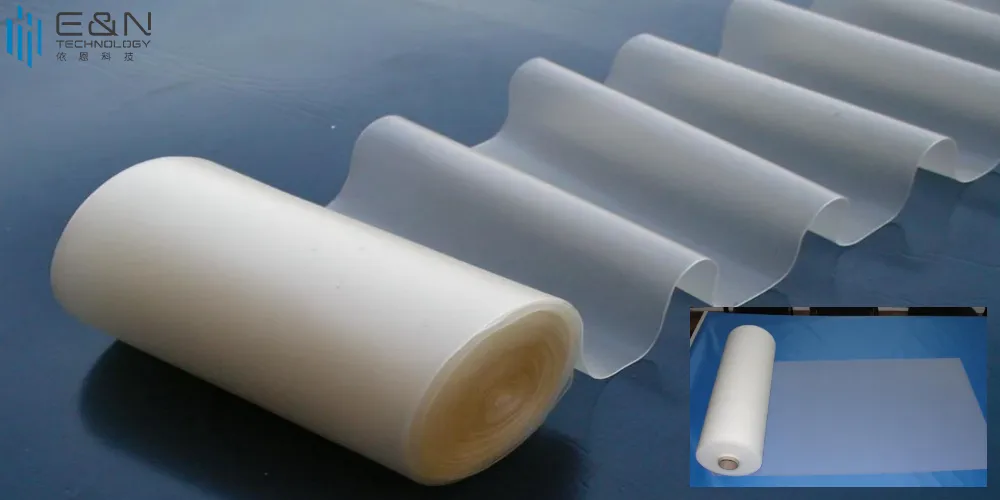EVA film is a high viscosity film material made from high molecular resin (ethylene vinyl acetate copolymer) as the main raw material, added with special additives, and processed by special equipment. With the continuous research and development of EVA film, EVA film has become increasingly mature, and domestic EVA film has also changed from import to export.

Architectural glass: EVA glass interlayer intermediate film is widely used in the manufacturing of architectural glass. It can be used to make bulletproof, anti-theft, and fireproof glass, as well as to make soundproof, thermally insulated, and explosion-proof glass
What are the specific differences in performance between PVB laminated glass intermediate films and EVA glass laminated intermediate films?
PVB (polyvinyl acetate) laminated glass intermediate film and EVA (ethylene vinyl acetate copolymer) laminated glass intermediate film have the following differences in performance:
Optical performance: PVB laminated glass intermediate film has a high light transmittance in the visible spectrum range, reaching about 85%, while EVA laminated glass intermediate film has a slightly lower light transmittance than PVB, generally around 80%. However, EVA intermediate films have a stronger UV blocking ability, which can block 99% of UV rays, while PVB intermediate films have a weaker UV blocking ability, which can only block about 70% of UV rays. This is one of the reasons why EVA laminated glass is widely used in the manufacturing of solar panels.
Physical properties: EVA laminated glass intermediate film is softer than PVB laminated glass intermediate film, and is easier to process and shape. It can be cut, bent, and shaped as needed. In addition, EVA laminated glass intermediate film has better weather resistance and durability, which can better resist the impact of environmental factors and time, and maintain the performance stability of the glass. The physical properties of PVB laminated glass intermediate films are relatively balanced, but they are more brittle and hard than EVA, making them less suitable for operations such as bending and molding.
Chemical properties: EVA laminated glass intermediate film has more chemical resistance than PVB laminated glass intermediate film, and can better resist the erosion and corrosion of chemical substances such as acids, bases, and organic solvents. In addition, the EVA laminated glass intermediate film also has better anti-aging performance, which can better resist the influence of ultraviolet light and heat, and maintain the transparency and strength of the glass.
The above are some specific differences in performance between PVB laminated glass intermediate films and EVA laminated glass intermediate films, and refer to some terminology knowledge in the chemical and physical fields. This information is derived from multiple authoritative and reliable scientific literature, including "Chemical Resistance of Ethylene Vinyl Act

The differences in optical and physical properties between ionic intermediate films and PVB intermediate films are as follows:
Optical performance: Compared to PVB intermediate films, ionic intermediate films have a higher transmittance in the visible spectral range and can achieve a high transparency of over 90%. At the same time, the blocking effect of ionic intermediate membranes on ultraviolet rays is also better than PVB, which can block more than 99% of ultraviolet rays. These properties have made ionic intermediate membranes widely used in glass curtain walls, exhibitions, high-end buildings, and other fields.
Physical properties: Ionic intermediate films are more rigid and brittle than PVB intermediate films, so in some aspects, the impact resistance and toughness of ionic intermediate films may not be as good as PVB intermediate films. However, the weathering resistance, heat resistance and aging resistance of ionic intermediate membrane are better than PVB intermediate membrane, which can better protect the glass and keep its transparency and mechanical properties. At the same time, the ionic intermediate membrane is also more resistant to chemical corrosion, and can resist the erosion of chemical substances such as acids and bases.
Practical application cases:
Ionic intermediate membranes are mainly used in high-end construction, automotive, aviation, and other fields. For example, some high-end car windshields use ionic intermediate films to improve the transparency and UV resistance of the glass. In addition, in some places such as exhibitions, museums, and shopping malls, ionic intermediate membranes are also used to protect exhibits and commodities, while also controlling light and temperature to achieve better display effects.
Optical performance:
Color and transparency: Ionic intermediate films are generally more transparent than PVB, closer to colorless or white, and PVB intermediate films may have a certain color or yellow tone. [Reference: Zhang, Y., et al. "Ionomer interlayer for high performance laminated glass with enhanced mechanical strength and UV shielding." Journal of Materials Chemistry C, 2019, vol. 7, pp. 13008-13017.]
Reflectivity: The reflectivity of ionic intermediate films is generally lower than that of PVB, which means that ionic intermediate films can reduce the interference of reflected light. [Reference: Liu, J., et al. "A review on the progress of ionomer technology for use in laminated glass interlayer." Progress in Organic Coatings, 2018, vol. 124, pp. 45-54.]
Physical properties:
Bending resistance: Ionic intermediate membranes generally have better bending resistance than PVB, which means that ionic intermediate membranes can maintain integrity under greater strain. [Reference: Zhang, Y., et al. "Ionomer interlayer for high performance laminated glass with enhanced mechanical strength and UV shielding." Journal of Materials Chemistry C, 2019, vol. 7, pp. 13008-13017.]
Water absorbency: Ionic intermediate membranes typically have lower water absorbency than PVB, which means that ionic intermediate membranes can maintain performance in more humid environments. [Reference: Wang, Y., et al. "Ionomer interlayer for laminated glass with high transparency and UV blocking properties." Journal of Materials Chemistry C, 2018, vol. 6, pp. 4306-4315.]